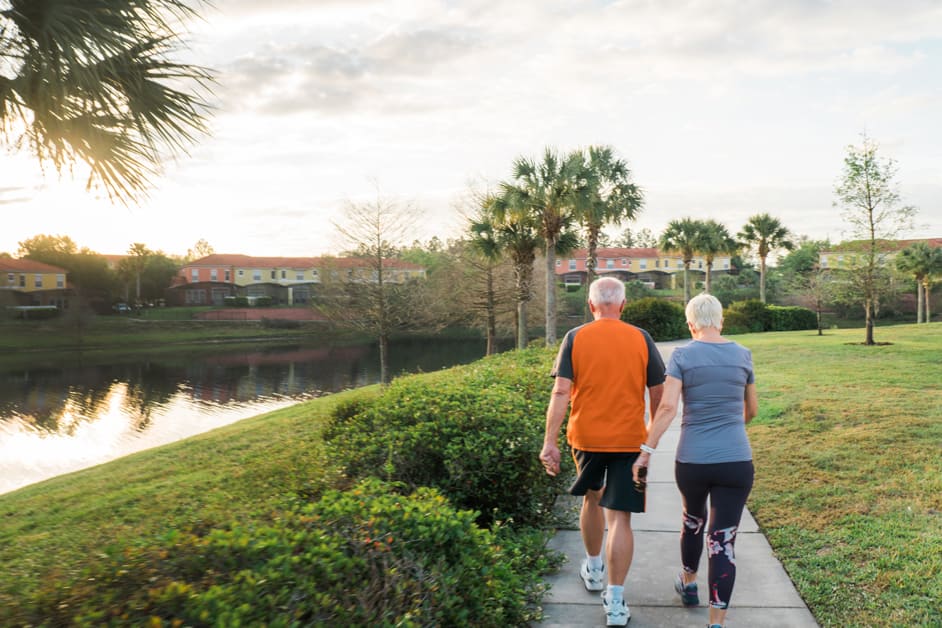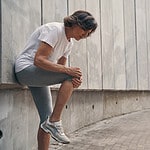Exercise
Exercise is a powerhouse to fight knee pain from overuse. Workouts can help your knee joints by strengthening the muscles that support them. Stretching these muscles can ease the discomfort of overuse injuries.
Here are some exercises to lessen the knee pain intensity:
Strength Training
Strength training is crucial for an exercise routine, especially those with chronic knee pain. It can help strengthen the muscles around the knee joint, reduce pressure, and offer added support. Working out your quads and leg muscles can also lower the risk of injury.
Here are some strength training exercises:
- Goblet squats: Stand hip-width apart, hold a weight close to chest. Squat down, push hips back and keep chest up. When knees reach 90 degrees, drive through heels, release hips, stand until fully upright.
- Leg press: Lie on back, feet flat on machine, knees bent at 90 degrees. Push off the platform with both feet until legs straighten out, then slowly return.
- Lunges: Start standing. Step forward into lunge position, front thigh parallel to ground. Press up from front heel.
- Calf raises: Step onto a step. Rise slowly onto toes until calf is contracted. Lower back down until heels hang off edge.
Low-Impact Cardio
Low-impact cardio workouts are great for boosting fitness and can even reduce pain in the knee joint. Unlike high-impact activities, these exercises are less stressful on joints, while still letting you burn calories and improve your heart health.
Try these low-impact exercises:
- Swimming
- Brisk walking
- Cycling (stationary or outdoors)
- Water aerobics
- Elliptical machines
- Rowing
When doing any of these exercises, pay attention to your body. If you experience intense pain or discomfort, get professional guidance. Start slow and gradually increase intensity and duration as you become more fit.
Stretching
Stretching is key for knee pain reduction due to overuse. Before and after any strenuous knee activity, make sure to stretch the muscles around your knees.
Static stretching is low intensity and beneficial. It involves sitting or standing and holding a position – like grabbing your toes – for around 20-30 seconds.
Dynamic stretching involves more movement and requires you to move through positions multiple times, usually 6-10 sets. Examples are lunges, squats and wall/floor slides.
When stretching, it’s important to focus on the muscles that support your knees: hamstrings and calves (back of legs), quadriceps (front of legs), glutes, hip flexors/extensors (hips), lower back muscles and the IT band (outer thigh area).
When stretching these muscle groups, keep good alignment. Push yourself gently into each stretch without bouncing or jerking movements. You should feel a pulling sensation, but no pain or discomfort.
Diet
Your diet may help with overuse knee pain. Vitamin C, omega-3 fats, and vitamin D can reduce inflammation and swelling. For healthy knees, eat leafy greens, fatty fish, and dairy. These provide the body with nutrients. Have a closer look at how your diet can help with alleviating knee pain.
Increase Intake of Anti-Inflammatory Foods
An anti-inflammatory diet can be helpful for many conditions, including knee pain caused by overuse. Chronic inflammation can damage body parts. Eating anti-inflammatory fruits and veggies, proteins, nuts, seeds and spices can reduce inflammation and ease symptoms.
Examples of foods to help with knee pain:
- Strawberries, blueberries and cherries
- Kale, spinach and broccoli
- Salmon and fatty fish with omega 3 fatty acids
- Olive oil and coconut oil with healthy fats
- Walnuts, almonds and other essential fatty acid-rich nuts and seeds
- Ginger and turmeric with anti-inflammatory antioxidants
It’s important to have a balanced diet. Eating whole foods instead of processed food can help avoid additives that can cause inflammation.
Reduce Intake of Processed Foods
Refined sugars, saturated fats, and processed foods can do harm to knee health. They cause inflammation, which can be a major source of chronic knee pain. Instead, eat fruits, vegetables, lean proteins, whole grains, and healthy fats.
High-fiber foods like fruits and oats can help fight constipation and keep joints lubricated. Eating small meals more often is better than eating one or two large meals. This helps stop blood sugar spikes, and keeps your knees from being strained.
Lastly, get healthy omega 3 fatty acids like wild caught salmon, chia seeds, and hemp hearts into your diet. Omega 3s have been shown to reduce inflammation with regular consumption.
Increase Intake of Omega-3 Fatty Acids
Omega-3s are essential nutrients that keep body cells healthy. They help maintain joint function, reduce inflammation, and protect against cartilage damage in overused joints, like knees. Studies suggest that omega-3s may even reduce knee pain.
Sources include cold-water fish, vegetable oils, nut products, and eggs enriched with omega-3s. Eating these can help reduce overuse knee pain, and benefit overall health.
Lifestyle Habits
Want to ease knee pain from overuse? Alter your lifestyle! Adjust physical activities, modify your diet, and make wise decisions on how you use your joints. Here’s more info on the best lifestyle habits to help manage knee pain:
Wear Proper Footwear
Poor foot mechanics and bad shoes can cause knee pain. Wearing the right type of shoes can improve mechanics, reduce knee stress, and ease knee pain.
Pick shoes based on your activity level. If you’re a runner, get new ones every 300-500 miles. If you’re not a runner, change them every 12-18 months. Shoes should fit the activity – cushioning and stability vary. Orthotic inserts can also provide support for walking and turning. Get custom ones from a podiatrist.
When choosing closure and style, make sure it offers adequate support. This will protect your knees and reduce the risk of knee pain.
Maintain Proper Posture
Maintaining good posture is a key way to stop overuse knee pain. When you sit and stand, align your upper body with your lower body. This can reduce strain on the joint and also help prevent muscle imbalances that cause inflammation.
Imagine there’s a rope going through your body from your head to your toes. Pull it against gravity and stand tall. Keep your shoulders above your hips, with natural curves in the lower back. When standing, make sure your hips are level, the weight is evenly distributed between both feet, and your knees are directly above your ankles. Check for tension and reposition if needed.
Be aware of activities at home that put strain on your knees, like:
- Sitting with your legs crossed for too long
- Kneeling on one knee
- Sitting slouched on a sofa
Take regular breaks or find alternatives to avoid putting stress on your knees. For example, use a trowel when gardening instead of digging by hand.
Take Breaks When Sitting or Standing for Long Periods
Take breaks when sitting or standing for too long. Move around, stretch and change positions throughout the day. Vary the angle of your seat or use a sit-stand desk to reduce stiffness and improve posture. Shift your weight between feet when standing. Take softer steps on hard floors. Place a cushion to prop up one foot to provide relief from standing.
Alternative Treatments
For those with knee pain due to overuse, alternative treatments are worth considering. These treatments may involve lifestyle changes – some simple, some complex. Let’s take a look at the simple changes you can make to help with your knee discomfort:
- …
- …
- …
Acupuncture
Acupuncture is a Chinese medical practice. It involves stimulating certain points on the body. This can be done through thin metal needles or electrically. The aim is to bring balance to the body.
Reports say it helps reduce knee pain caused by overuse or chronic joint pain. Studies have shown that acupuncture treatments for knee osteoarthritis can give short-term relief. Patients who get regular acupuncture treatments experience less pain and fewer side effects than drugs or surgery.
Not only does it lessen knee pain, but it can also reduce inflammation in other parts of the body. This may improve overall physical health of those with chronic knee conditions like arthritis and tendonitis.
Massage Therapy
Massage is a great alternative for knee pain. It can reduce tension in muscles and soften connective tissue, as well as boost the circulation around the knee. This helps reduce inflammation and even lets the body produce endorphins, which stop pain.
A professional healthcare provider or massage therapist should be consulted to decide the best massage techniques for your knee-overuse problem. These include: cross-fiber friction, Swedish massage, trigger point release, and deep tissue massage.
These might be uncomfortable at first, but they work to reduce chronic pain due to overuse injuries. They do this by reducing muscle tension and correcting the muscle imbalances that overuse causes. Results may vary from person to person depending on their age, lifestyle, activity level, injury history, and treatment goals.
Ice/Heat Therapy
Ice and heat therapy can be an alternate way to ease knee pain caused by exercise and overuse. You can use cold packs, heating pads or hot and cold compresses during the day to reduce inflammation and decrease the pain.
Ice should be applied for 20 minutes at a time throughout the day. Don’t put it directly on the skin. Use an ice pack or a wet cloth like an old t-shirt instead.
Heat shouldn’t touch your skin either. Use a heating pad or hot compress instead for 15-20 minutes, up to three times a day. If it doesn’t help, switch back to cold therapy after talking to your doctor for help.
Medical Treatments
Is your knee pain still persisting? There are medical treatments to help! Maybe you need medicine to decrease the pain, inflammation, and stiffness. Physical therapy could be an option as well. It would improve your range of motion, strengthen your muscles, and help reduce the pain. Surgery may even be necessary in some cases.
Let’s discuss these medical treatments for overuse knee pain further:
- Medicine
- Physical therapy
- Surgery
Physical Therapy
Physical therapy, or physiotherapy, is a medical specialty that looks at issues with movement. It diagnoses and treats problems caused by physical injury, disease, or illness. Therapists use exercises, massage, and other techniques to improve movement, flexibility, and strength. The goal is to help people do daily activities with less effort.
Common treatments are:
- Joint mobilization
- Myofascial release
- Neuromuscular retraining
- Exercise prescription
- Postural re-education
- Aquatic therapy
- Electrical stimulation
- Heat/cold application
- Ultrasound therapy
- Kinesio taping
Therapists also provide education on proper body mechanics and gait training. Assistive devices such as canes, walkers, and crutches may also be used.
Corticosteroid Injections
Corticosteroid injections are potent drugs used to reduce inflammation and pain in certain parts of the body. They’re often used to treat many medical ailments, and can offer quick relief. Common uses include tendinitis, bursitis, carpal tunnel syndrome, and joint pain.
Before receiving a corticosteroid injection, your doctor may order lab tests to see if there’s an underlying cause that needs to be addressed. They may also suggest other treatments like physical therapy or lifestyle changes first.
The procedure for receiving a corticosteroid injection differs based on the type and location of the injection, but usually follows the same protocol. You’ll be asked to remove any jewelry or items obstructing access to the injection site. You may also need to take off clothing for your doctor to have better access. Your doctor will use an anesthetic to numb the area, then administer the steroid with either a syringe or needle. Don’t move during the procedure, as this can cause incorrect placement of the medication.
Corticosteroid injections are usually very successful in providing pain relief in areas like joints that can’t be treated with oral medications or physical therapy. But, don’t get more than one injection within 3 months due to potential side effects like
- tendon weakness
- discolored skin around the injection site
- tissue death
- systemic absorption
Talk with your healthcare provider to see if corticosteroids are right for you.
Surgery
For those with severe knee pain, surgery could be advised. The type of surgery depends on the damage to the knee.
Arthroscopic surgery is a minimal invasive surgery. It involves putting a tiny camera and special tools into the knee joint via a few small incisions. During the procedure, the doctor can repair ligaments, heal cartilage tears and reconstruct tissue around the joint.
Arthroplasty is another type of surgery for pain from overuse injuries. It consists of replacing the damaged joint with a metal or plastic artificial one. This operation is less common, but may be recommended if other treatments have not relieved pain for more than six months.
Frequently Asked Questions
Q: What are some simple lifestyle changes I can make to help alleviate overuse knee pain?
A: There are several lifestyle changes you can make to help alleviate overuse knee pain. These include: exercising regularly to strengthen the muscles around the knee, losing excess weight to reduce the strain on the knee, avoiding high-impact activities such as running or jumping, and wearing supportive shoes with good arch support. Additionally, stretching the muscles around the knee can help to reduce the pain.
Q: What kind of exercise is best for relieving overuse knee pain?
A: Low-impact exercises such as swimming, cycling, and walking are good for relieving overuse knee pain. Strengthening exercises such as squats, bridges, and leg curls can also be beneficial. It is important to listen to your body and stop exercising if it begins to hurt.
Q: What other remedies can I use to help with overuse knee pain?
A: Applying ice or heat to the affected area can help to reduce inflammation and pain. Over-the-counter pain relievers such as ibuprofen can also be used to help reduce pain and inflammation. Additionally, massage or physical therapy may be beneficial in helping to reduce pain and improve range of motion.





